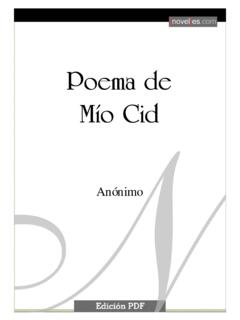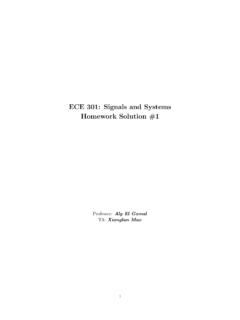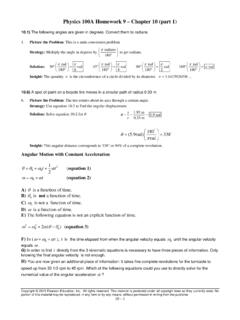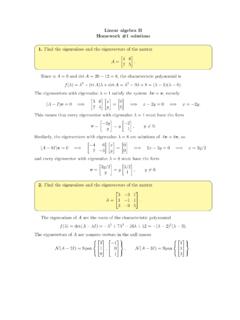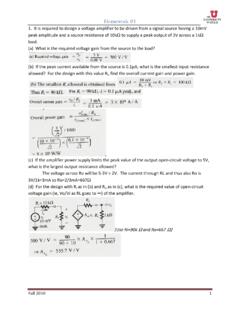Transcription of MATH 125 Probability Homework Problem 1.
1 math 125 Probability HomeworkProblem 1. Assume that P(A) = and P(B) = for all parts of this Problem . Find the following probabilities:a.) What is P(B )?P(B ) = 1 - P(B) = 1 - = ) Given that P(A and B) = , find P(A or B).P(A or B) = P(A) + P(B) - P(A and B) = + - = ) If A and B are mutually exclusive, what is P(A and B)?By the definition of mutually exclusive, that is ) If A and B are mutually exclusive, what is P(A or B)?P(A or B) = P(A) + P(B) - P(A and B) = + - = ) Given that P(A or B) = , find P(B*A).Two steps (A or B) = P(A) + P(B) - P(A and B) = + - P(A and B) = P(A and B)Now we use:P(A and B)= P(A) P(B*A) = P(B*A) = P(B*A)f.) Given that P(A*B) = what is P(A and B)?P(A and B)= P(B) P(A*B) = * = ) If A and B are independent, what is P(A and B)?P(A and B)=P(B) P(A) since they are ind. = * = ) If A and B are independent, what is P(A or B)?
2 As in part g, P(A and B)= Now use the addition rule:P(A or B) = P(A) + P(B) - P(A and B) = + - = 2. Assume that P(A) = and P(B) = for all parts of this ) If A and B are independent, what is the Probability of P(A and B)?P(A and B)=P(B) P(A) = * = ) Can A and B be mutually exclusive? Justify your they are, then P(A or B) = P(A) + P(B). (Do you know why?) This presents a Problem , for then P(A or B) = the answer is 3. A box contains three cokes and two beers (root beer of course). Julie draws at random twice withoutreplacement from the box. (Any draw is equally likely)a.) What is the Probability that she gets at least one beer?From a tree diagram, (2/5)(1/4) + (2/5)(3/4) + (3/5)(2/4).b.) What is the Probability that she drew a coke on the first draw given that she drew a beer on the second draw?Let A be she drew a coke on the first draw and B be she drew a beer on the second draw .We want to find P(A|B).
3 Recall P(B)P(A|B) = P(A and B). Find P(B) and P(A and B) from the tree diagram. They are and , respectively. Thus P(A|B) = c.) Are the events Julie draws a beer on the first draw and Julie draws a beer on the second draw independent? No. To show it, (which would be required on a test) show that P(A and B) isn t the same as P(A)P(B). Problem 4. A box contains three cokes and two beers. James draws at random twice with replacement from the box. (Anydraw is equally likely)a.) What is the Probability that he gets at least one beer?1-(3/5)2b.) What is the Probability that he drew a coke on the first draw given that he drew a beer on the second draw?3/5c.) Are the events James draws a beer on the first draw and James draws a beer on the second draw independent?Yes. The two trials are independent as they are with 5. Draw from the box containing 1,2,3 and 4 twice without ) Let A be the event that the sum of the draws is even. Let B be the event that the first draw is odd.
4 Find the probabilitiesof each of these = {(1,2), (1,3), (1,4), (2,1), (2,3), (2,4), (3,1), (3,2), (3,4), (4,1), (4,2), (4,3)}The event A = {(1,3) , (2,4) ,(3,1) ,(4,2) }. P(A) = 4/12 = 1 ones have odd first number, that is, B = {(1,2), (1,3), (1,4) ,(3,1) ,(3,2), (3,4) }. P(B) = 6/12 = 1/2 These ones are in both A and B (just look above). A and B = {(1,3) (3,1)} So P(A and B) = 2/12 = 1 ) Are A and B mutually exclusive? No. P(A and B) = 2/12 = 1 ) Are A and B independent?Are A and B independent? Only if P(A and B) = P(A) P(B). They are since, P(A) P(B) = (1/3) * (1/2) = 1/6 is equalto P(A and B). Problem 8. Janice wants to become a police officer. She must pass a physical exam and then a written exam. Records showthe Probability of passing the physical exam is and that once the physical exam is passed the Probability of passing thewritten exam is )What is the Probability that Janice passes both exams? A direct translation of the language above is This:P(Pass Physical) = P (Pass Written | Pass Physical) = By the multiplication rule, P(Pass Written and Pass Physical) = P (Pass Written | Pass Physical) * P(Pass Physical) = * = b)What is the Probability that Janice fails the written exam if she has already passed the physical exam?
5 This is the compliment of the event (Pass Written | Pass Physical). So the answer is 1 - = 9. Suppose a missile defense grid can shoot down 95% (a complete technological miracle) of all incoming nuclearmissiles. Assume that nuclear warheads are just part of a missile for this Problem . What is the Probability that out of 10incoming nuclear missiles, all of them are shot down? You may assume that shooting missiles down are independent events. (Getting political here: these are absurd assumptions. Tracking multiple ICBM s simultaneously would undoubtably lowerthe chance of countering more than one of them. The real-world Probability of shooting down an ICBM is certainly muchlower than 25% in extremely controlled situations.) Geez, who let this guy out of the math dept and onto the web, lol. Anyway, it is ( .95)10 which is about of the time.
